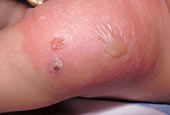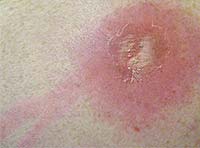Cellulitis is one of the most painful, quickly spreading and potentially deadly types of infections that can be caused by Staph or MRSA. Because these infections are becoming more common, it’s best to know what to look for and what to do if you think you have it. MRSA cellulitis can take a long time to get rid of. And like other types of MRSA and Staph, it is prone to recurring and can be difficult to treat.
Fortunately, there are both antibiotic drug and potent alternative options for controlling cellulitis. Becoming more familiar with the symptoms, risk factors and treatment options below is a good first step if you’re struggling with an infection.
What is cellulitis?
Cellulitis is a deep infection of the skin and the underlying tissues. If left unchecked, cellulitis can quickly lead to more dangerous infections of the blood (sepsis), bone (osteomyelitis) and heart (endocarditis) and in some cases tissue death (gangrene).
Cellulitis symptoms

Cellulitis is a deeper soft tissue infection that can worsen rapidly.
Photo credit: CDC/Mathies
Cellulitis infections are most common on the lower legs, face and arms, but they can occur anywhere on the body. Children often get this infection on their bottom. The most common symptoms are red, warm and tender skin, but these infections can have many other symptoms as well. Looking a cellulitis pictures can be a helpful tool. Possible warning signs and indications of cellulitis include:
- Redness of the skin area, which often grows in size over time
- Swelling or inflammation of the area, which often gets bigger over time
- Red streaks radiating outward may occur, which often spread outward over time
- Pain and tenderness in the area
- Skin that is warm to the touch in the infected area.
- Skin sores, bumps and small pimples can sometimes occur
- A rash or red patches in the area may occur
- Skin sometimes appears stretched, tight or shiny in the area
- Fever, chills, sweating or shaking can occur
- Feeling ill, weak or having muscle aches can occur
- Nausea, joint stiffness and hair loss in the area may occur in some cases
Who’s at risk?
There are many risk factors for cellulitis, some more significant than others. Any of the factors below, either by themselves or in combination, can increase the risk of catching cellulitis:
- Any cuts, scrapes, cracks, burns, blisters or open wounds on the skin provide an easy entry for bacteria.
- Surgical wounds, catheter sites and IV injection sites are very common places to get cellulitis and other infections.
- Dry or peeling skin, Athlete’s foot, eczema, shingles, chickenpox and other skin conditions can make your skin more vulnerable to getting infected.
- Insect or animal bites or stings can easily become infected.
- The elderly and people with weakened immune system have a higher risk of cellulitis and other infections.
- A long term stay in a hospital, nursing home or other healthcare facility can increase your exposure to MRSA and many other infections.
- Taking medications that depress the immune system, including corticosteroids and antirejection drugs, make you more prone to infections in general.
- Ulcers caused by Diabetes or vascular disease are a risk factor.
- Swollen legs or arms caused by either medical conditions (such as cirrhosis, scleroderma or congestive heart failure) or by medications (such as diuretics or water pills) increase the risks of cellulitis.
- Conditions that weaken the immune system, including diabetes, HIV/AIDS, circulatory disorders, liver disease, kidney disease and leukemia can make you more prone to many types of infection.
- IV drug use is another risk factor for many types of infection.

Red streaks spreading out from an infection is one possible danger sign of a worsening cellulitis infection.
What should you do?
Cellulitis can be quite dangerous and should be taken very seriously. If you think you have cellulitis, it’s best to get medical attention as soon as possible. If the infection is spreading or growing, or if it causes chills or fever, it’s crucial to get immediate medical attention. These infections are even more serious if they occur on your face or in other sensitive areas of the body.
Cellulitis treatment
Antibiotics are the most common mainstream medical treatment for cellulitis. Mild cases are often treated with oral antibiotics that can be taken at home. Moderate and severe infections are usually treated with IV antibiotics in a hospital. Recovery can take a few days to several months, depending on the severity of the infection and other complicating health problems.
While there are several natural remedies that can be used for treatment, it’s best to be under the close supervision of a doctor for these challenging infections, regardless of which treatments you use. Natural remedies of high potency taken in larger doses are usually needed. Because higher doses of any natural product can lead to sensitivity, detoxification, liver toxicity and other symptoms, it’s best if your doctor is familiar with these symptoms and the particular remedy you are using.
Short-term use of therapeutic grade oregano oil taken internally in moderate to high doses is one natural method that has been used. Other essential oils, such as ravensara, clove and cinnamon bark, have been used internally for challenging infections, along with milder oils, such as tea tree, for external skin support. High doses of stabilized allicin and specialized medicinal herbal blends, such as Olive Leaf extract, have also been used for these infections. As with any natural remedy, treatment alone is usually not enough. Additional steps should be taken to boost the immune system and repair damage done by bacteria and drugs, especially for severe infections.
Depending on the circumstances, both antibiotic drugs and natural remedies have been used together. Getting your mainstream medical doctor to collaborate with your Naturopathic Doctor is one of the best ways to get comprehensive holistic health care.
To your best health,
Michelle

Microbiologist and Natural Health Expert




